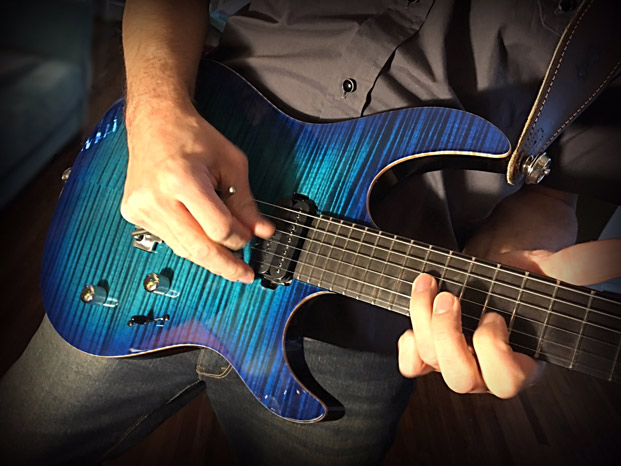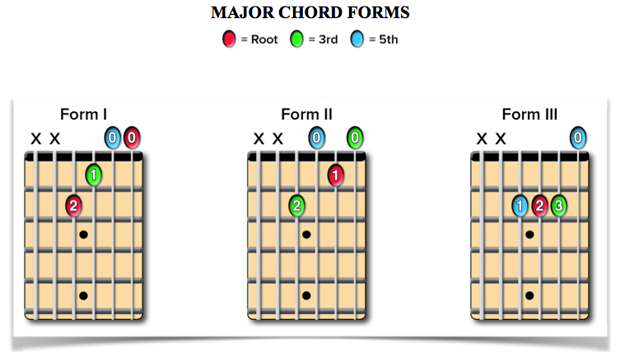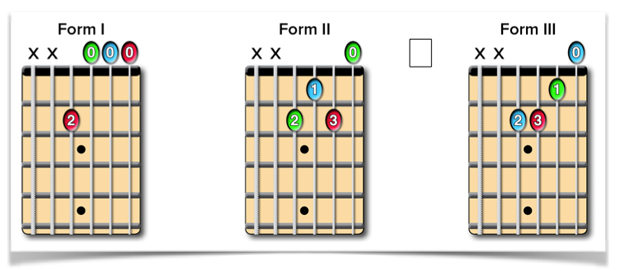Expand Your Musicality and Fretboard Knowledge Using Triads and Inversions

When first learning to play guitar, transitioning between chords and playing a few progressions can allow you to play hundreds of songs.
While this can keep you entertained for quite a while, you might find there is a large amount of the fretboard that is lacking your attention.
One of the many tools that can be used to learn the higher positions is the CAGED system. Though the application can be very useful, aspects of it can be simplified and studied in a more musical approach. Doing this might help you have a better understanding of chord voicing and harmony.
The CAGED system uses five guitar chord shapes—C, A, G, E and D—to create barre chords for playing in higher positions. The problem with this system is that its functionality has nothing to do with music itself. It is simply a physical device that works based on the tuning of the strings. It cannot be applied to music in general and is specific only to the guitar.
These five chords are all root-position chords, meaning the letter name of the chord is the lowest-sounding note. But music does not always consist of root-position chords, so why should it on the guitar? In this column, I’ll demonstrate another approach for expanding your fretboard knowledge using triads and their inversions.
First of all, what is a chord? If you’re asked to play a G chord, what really does that mean? Sure, it can be a shape from a chord diagram, but why that shape? And if it’s different from one diagram to the next, is one of those wrong?
As guitarists, we often think about chords as shapes, and we have “go-to” shapes for certain chords. But that’s not thinking musically. So that we can develop a stronger sense of musicianship, we need to understand how chords are constructed. To demonstrate, I’ll use a simple I-V-vi-IV progression in the key of A, so the chords will be A, E, F♯m and D.
First, we need to know what notes are in the key of A.

The basic chord is called a triad and consists of a root, a third and a fifth. The chords in this progression will have these notes:
A: A, C♯, E
E: E, G♯, B
F♯m: F♯, A, C♯
D: D, F♯, A
Your “go-to” shapes for these chords might look something like this:

When first learning to play a chord progression, we’re typically using our basic “guitar” chords. I use quotations because many guitarists think of a chord as a certain shape. That may suffice for a beginner, but to make those root-position chords even more musical, we need to take advantage of the rest of the fretboard. We can do so by learning different chord inversions.
As there are three different notes in a basic chord (triad), there are three basic forms for these chords. These forms are presented only on the top four strings. The reasoning for this is twofold:
01. Historically, the developing guitar was a four-string instrument until the Baroque era, when a fifth string was added, and then a sixth. Therefore, chords had to be formed on fewer strings.
02. Chords formed on the top four strings involve a systematic, musical approach to triadic harmony and the use of chord inversions.

Form I Voicing: 1-3-5-1 (root, third, fifth, octave)—“root-position.”
Form II Voicing: 3-5-1-3 —“first inversion.”
Form III Voicing: 5-1-3-5—“second inversion.”


There is a clear pattern of intervals with this system of chord inversions. While the official term is “inversion,” using form numbers can help to identify where the root of the chord is. For example, the root in Form I is on the first string, it’s on the second for Form II, and the third for Form III. This applies to both Major and Minor Forms.
Applying these forms to the chord progression, A, E, F♯m, D, will give us three different fretboard locations, with each of these having a different sound because of the different chord voicings. The transition from one form to the next is designed so that common chord tones may be used where applicable, and shifting is kept to a minimum.
EXAMPLE 1:

EXAMPLE 2:

EXAMPLE 3:

Each of these examples systematically moves through the different chord inversions, and they create sounds very different from the basic, root-position shapes.
Learning these six total forms can be much easier than the learning CAGED system. With its musical approach, the focus is on specific chord voicing rather than just root-position chord shapes. Through using these, you can expand your fretboard knowledge in a musical way and gain a better understanding of how chords function. Sonically, if you’re playing the same progression with another guitarist, each of you can play the same chords, but in different positions, creating a wider spectrum of sound.
This method of learning chords is presented in my iBook, Beginning Guitar Method, which is available in the Apple iBookstore.
Matthias Young teaches online guitar lessons at FreeGuitarVideos.com and is the Head of Guitar at Callanwolde Fine Arts Center in Atlanta, Georgia. His book and DVD, Metal Guitar Method, has sold thousands since its publication in 2012. His most recent release, Beginning Guitar Method, is available in the Apple iBookstore. You can follow Matthias on Facebook, Twitter, YouTube and Google+.
Get The Pick Newsletter
All the latest guitar news, interviews, lessons, reviews, deals and more, direct to your inbox!
Matthias Young has studied music performance and education at Berry College, Georgia State University, and Boston University. He’s published articles for Guitar World and The Guitar Foundation of America’s Soundboard. He is the author of several guitar methods, including the best-selling Metal Guitar Method and Guitar Quest: Essentials. If you’re interested in studying with Matthias, he offers online lessons over Skype, or you can learn from hundreds of videos from multiple instructors available at Guitar Compass.








![Joe Bonamassa [left] wears a deep blue suit and polka-dotted shirt and plays his green refin Strat; the late Irish blues legend Rory Gallagher [right] screams and inflicts some punishment on his heavily worn number one Stratocaster.](https://cdn.mos.cms.futurecdn.net/cw28h7UBcTVfTLs7p7eiLe.jpg)

